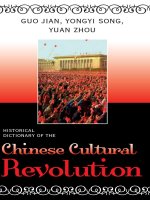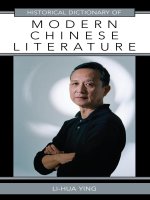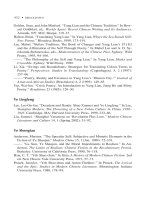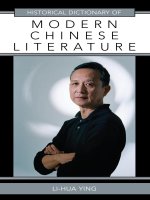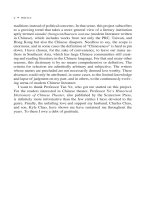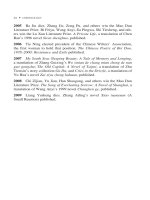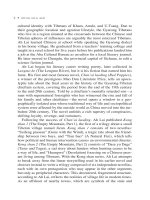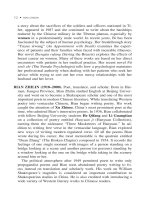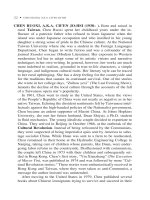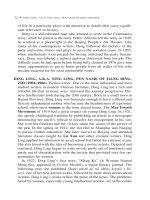historical dictionary of the chinese cultural revolution
Bạn đang xem bản rút gọn của tài liệu. Xem và tải ngay bản đầy đủ của tài liệu tại đây (20.1 MB, 504 trang )
Revolution
GUO JIAN, YONGYI SONG,
YUAN ZHOU
IiIiIiIiIiIiIiIiIiIi
GUO, SONG,
& ZHOU
Revolution
HISTORICAL
DICTIONARY
OF THE
ASIA • HISTORY
Historical Dictionaries of Ancient Civilizations and Historical Eras, No. 17
“A much-needed dictionary—complete, authoritative, and clear—for the Orwellian language of
late Maoism in China.”—Perry Link, professor, East Asian Studies Department, Princeton
University
There has never been anything quite like the Cultural Revolution, which disrupted life in the
People’s Republic of China from 1966 to 1976. It wreaked havoc in the world’s most populous
country, often turning life upside down and undermining the party, government, and army,
weakening the economy, society, and culture. Tens of millions were hurt or killed during this period,
and relatively few benefited, aside from Mao Zedong and (temporarily) the Gang of Four.
Historical Dictionary of the Chinese Cultural Revolution provides an extensive chronology that traces
the events of the revolution and the introduction puts those events in context and explains them.
The bulk of the information is provided in numerous dictionary entries on important persons,
places, institutions, and movements. The bibliography points to further resources, and the glossary
helps those researching in Chinese.
GUO JIAN is a professor of English and Chinese at the University of Wisconsin–Whitewater.
YONGYI SONG is on the library faculty at California State University, Los Angeles.
YUAN ZHOU is the curator of the East Asian Library of the University of Chicago.
For orders and information please contact the publisher
SCARECROW PRESS, INC.
A wholly owned subsidiary of
The Rowman & Littlefield Publishing Group, Inc.
4501 Forbes Boulevard, Suite 200
Lanham, Maryland 20706
1-800-462-6420 • fax 717-794-3803
www.scarecrowpress.com
Cover photo courtesy of the Virtual Museum of the Cultural Revolution
( part of the China News Digest
().
HISTORICAL
DICTIONARY OF THE
iIiIiIiIiIiIiIiIiIiI
ISBN-13: 978-0-8108-5461-1
ISBN-10: 0-8108-5461-9
9 780810 854611
90000
HDCulturalRevOFFLITH.qxd 6/21/06 10:09 AM Page 1
HISTORICAL DICTIONARIES OF ANCIENT
CIVILIZATIONS AND HISTORICAL ERAS
Series editor: Jon Woronoff
1. Ancient Egypt, Morris L. Bierbrier, 1999.
2. Ancient Mesoamerica, Joel W. Palka, 2000.
3. Pre-Colonial Africa, Robert O. Collins, 2001.
4. Byzantium, John H. Rosser, 2001.
5. Medieval Russia, Lawrence N. Langer, 2001.
6. Napoleonic Era, George F. Nafziger, 2001.
7. Ottoman Empire, Selcuk Aksin Somel, 2003.
8. Mongol World Empire, Paul D. Buell, 2003.
9. Mesopotamia, Gwendolyn Leick, 2003.
10. Ancient and Medieval Nubia, Richard A. Lobban Jr., 2003.
11. The Vikings, Katherine Holman, 2003.
12. The Renaissance, Charles G. Nauert, 2004.
13. Ancient Israel, Niels Peter Lemche, 2004.
14. The Hittites, Charles Burney, 2004.
15. Early North America, Cameron B. Wesson, 2005.
16. The Enlightenment, by Harvey Chisick, 2005.
17. Chinese Cultural Revolution, by Guo Jian, Yongyi Song, and Yuan
Zhou, 2006.
Gu000fm.indd iGu000fm.indd i 6/5/2006 9:17:43 AM6/5/2006 9:17:43 AM
Gu000fm.indd iiGu000fm.indd ii 6/5/2006 9:17:47 AM6/5/2006 9:17:47 AM
Historical Dictionary
of the Chinese Cultural
Revolution
Guo Jian
Yongyi Song
Yuan Zhou
Historical Dictionaries of Ancient Civilizations
and Historical Eras, No. 17
The Scarecrow Press, Inc.
Lanham, Maryland • Toronto • Oxford
2006
Gu000fm.indd iiiGu000fm.indd iii 6/5/2006 9:17:47 AM6/5/2006 9:17:47 AM
SCARECROW PRESS, INC.
Published in the United States of America
by Scarecrow Press, Inc.
A wholly owned subsidiary of
The Rowman & Littlefi eld Publishing Group, Inc.
4501 Forbes Boulevard, Suite 200, Lanham, Maryland 20706
www.scarecrowpress.com
PO Box 317
Oxford
OX2 9RU, UK
Copyright © 2006 by Guo Jian, Yongyi Song, and Yuan Zhou
All rights reserved. No part of this publication may be reproduced,
stored in a retrieval system, or transmitted in any form or by any
means, electronic, mechanical, photocopying, recording, or otherwise,
without the prior permission of the publisher.
British Library Cataloguing in Publication Information Available
Library of Congress Cataloging-in-Publication Data
Guo, Jian, 1953–
Historical dictionary of the Chinese Cultural Revolution
/ Guo Jian, Yongyi Song, Yuan Zhou.
p. cm. — (Historical dictionaries of ancient
civilizations and historical eras ; no. 17)
Includes bibliographical references.
ISBN-13: 978-0-8108-5461-1 (hardcover : alk. paper)
ISBN-10: 0-8108-5461-9 (hardcover : alk. paper)
1. China–History–Cultural Revolution, 1966–1976–Dictionaries. I. Song,
Yongyi,
1949– II. Zhou, Yuan, 1954– III. Title. IV. Series.
DS778.7.G86 2006
951.05'6–dc22 2005037614
The paper used in this publication meets the minimum requirements of
American National Standard for Information Sciences—Permanence of
Paper for Printed Library Materials, ANSI/NISO Z39.48-1992.
Manufactured in the United States of America.
Gu000fm.indd ivGu000fm.indd iv 6/5/2006 9:17:48 AM6/5/2006 9:17:48 AM
Editor’s Foreword vii
Acknowledgments ix
Reader’s Note xi
Acronyms and Abbreviations xiii
Map xv
Chronology xvii
Introduction xxxix
THE DICTIONARY 1
Glossary 363
Bibliography 375
About the Authors 433
Contents
Gu000fm.indd vGu000fm.indd v 6/5/2006 9:17:48 AM6/5/2006 9:17:48 AM
Gu000fm.indd viGu000fm.indd vi 6/5/2006 9:17:49 AM6/5/2006 9:17:49 AM
vii
Editor’s Foreword
Despite the tendency of history to repeat itself, some eras are truly unique,
the Chinese Cultural Revolution being a case in point. This was not a
revolution, nor was it a civil war; it probably came closer to a free-for-
all. There were different sides, but the membership constantly changed,
new ruling class against old ruling class, have-nots against haves, young
against elders, uneducated against educated, countryside against city—
just some of the dividing lines. This was exacerbated by ideology, but
power was an even stronger drive. Some of the slogans of the time prob-
ably defi ne it just as well, such as “turning the world upside down to
create a new world,” and it did look as if the monkey god had been let
loose. Yet, even then, someone was pulling the strings and this some-
one was an aging Mao Zedong, unwilling to tolerate any rival and even
to trust old comrades. For the greater part of the decade 1966–1976,
the Cultural Revolution wreaked havoc in the world’s largest society,
undermining the party, government, and army, weakening the economy,
society, and culture, and affecting China’s 800 million people and harm-
ing or destroying an eighth of the population. The strongest hope among
most of the survivors was never to live through such a period again and
to make it truly unique.
Given the confusion that reigned at the time and the uncertainty about
many events that still prevails today, it is essential to have a book like
this Historical Dictionary of the Chinese Cultural Revolution to help
clear up some of the points. This book does not claim to be the last word,
which is defi nitely in its favor, but it brings us another step closer to
understanding what still remains an extremely convoluted and confusing
era. This it does, fi rst, through a chronology tracing the events showing
at least what happened and when. The introduction then endeavours to
fl esh out the chronology by putting events and people in their places and
showing how these events and people relate to one another. The count-
less details are extensively elucidated in entries on signifi cant persons,
Gu000fm.indd viiGu000fm.indd vii 6/5/2006 9:17:49 AM6/5/2006 9:17:49 AM
places and institutions, the more momentous events, the political and
ideological movements, and much more. Since this did take place in
China, the glossary is a useful tool for those researching it in Chinese.
For those who want to know more, the bibliography is an excellent
starting point.
This volume was written by three scholars who lived through the
Cultural Revolution and therefore know the reality, as well as the theory.
Guo Jian, who was previously on the Chinese faculty at Beijing Nor-
mal University, is presently a professor of English at the University of
Wisconsin-Whitewater. Dr. Guo has written and lectured extensively on
the Cultural Revolution and the world of the 1960s. Yongyi Song, who
studied, among other places, at Shanghai Normal University, is now on
the library faculty at California State University, Los Angeles. He has
published The Cultural Revolution: A Bibliography, 1966–1996. Yuan
Zhou, who was a member of the Department of Library and Information
Science at Peking University, is currently the curator of the East Asian
Collection at the University of Chicago Library. Dr. Zhou has edited A
New Collection of Red Guard Publications: Part I. Each in his way has
contributed to a much-needed guide that is informative, comprehensive
and—much harder, given the circumstances—comprehensible.
Jon Woronoff
Series Editor
viii • EDITOR’S FOREWORD
Gu000fm.indd viiiGu000fm.indd viii 6/5/2006 9:17:49 AM6/5/2006 9:17:49 AM
Acknowledgments
Our gratitude must fi rst go to a number of colleagues and friends in
mainland China, whose works on the Cultural Revolution have been
invaluable resources to us but whose names we must leave out due to
the unwritten regulations regarding Cultural Revolution studies that the
current Chinese government put in place in recent years. We owe spe-
cial thanks to Mr. Gao Wenqian, to Dr. Wang Youqin of the University
of Chicago, and to Dr. Ding Shu of Normandale Community College,
whose pioneering studies and conversations benefi ted us immensely. We
are also thankful to Dr. Eric Purchase for his editorial assistance.
We are especially grateful to Mr. Yang Kelin, compiler and editor of
the photo collection The Cultural Revolution Museum, and to Mr. Li
Zhensheng, author of the photo album The Red-Color News Soldier, for
their generosity in permitting us to use the historical photographs from
their collections.
Separately, Guo Jian wishes to thank the City University of Hong
Kong for a generous visiting appointment in 2004, which afforded him
precious time much needed to fi nalize this collaborative effort. Yongyi
Song is grateful to Syracuse University’s School of Information Studies
and the American Library Association for their fi nancial and moral sup-
port in granting him, respectively, the “21st Century Librarian National
Award” in 2004 and the “Paul Howard Award for Courage” in 2005.
Yuan Zhou wishes to thank the Center for East Asian Studies at the
University of Chicago for funding the editorial work of the project.
ix
Gu000fm.indd ixGu000fm.indd ix 6/5/2006 9:17:50 AM6/5/2006 9:17:50 AM
Gu000fm.indd xGu000fm.indd x 6/5/2006 9:17:50 AM6/5/2006 9:17:50 AM
xi
Reader’s Note
The Romanization used in this dictionary for Chinese terms is the pin-
yin system that was developed and has by now become standard in the
People’s Republic of China. For example, the full name of Mao, the
CCP chairman, will be spelled Mao Zedong and not Mao Tse-tung or
otherwise. However, names of some well-known fi gures and institu-
tions (e.g., Confucius; Sun Yat-sen; Kuomintang; Tsinghua University),
already deeply embedded in English because of earlier transcriptions
according to the Wade-Giles or other conventions, are written here as
established terms.
The dictionary keeps personal names in the same order they assume
in Chinese: the family name precedes the given name. Thus the entry on
Mao Zedong can be found under M and not Z.
In the case of certain nonidiomatic and already well-known transla-
tions of Chinese terms (e.g., “Red Five Categories” for “hongwulei”),
the dictionary adopts these translations as established. The same applies
in the dating convention. For instance, the “May 16 Circular” is treated
as an established term although the consistent dating method used in this
dictionary is date followed by month (e.g., 16 May). For the reader’s
convenience, a glossary with pinyin spellings, Chinese characters, and
English translations is included as an appendix to the dictionary.
Since important bodies like the Chinese Communist Party (CCP)
and the People’s Liberation Army (PLA), as well as the country’s
name—People’s Republic of China (PRC)—are used repeatedly, in
many entries only the acronyms will appear. Bolding is used in the
dictionary section to indicate that there are specifi c dictionary entries
on the bolded items.
Gu000fm.indd xiGu000fm.indd xi 6/5/2006 9:17:50 AM6/5/2006 9:17:50 AM
Gu000fm.indd xiiGu000fm.indd xii 6/5/2006 9:17:51 AM6/5/2006 9:17:51 AM
xiii
CC Central Committee
CCP Chinese Communist Party
CCRSG Central Cultural Revolution Small Group
CMC Central Military Commission
GLD General Logistics Department
GPD General Political Department
PLA People’s Liberation Army
PRC People’s Republic of China
SC State Council
Acronyms and Abbreviations
Gu000fm.indd xiiiGu000fm.indd xiii 6/5/2006 9:17:51 AM6/5/2006 9:17:51 AM
Gu000fm.indd xivGu000fm.indd xiv 6/5/2006 9:17:51 AM6/5/2006 9:17:51 AM
Gu000fm.indd xvGu000fm.indd xv 6/5/2006 9:17:52 AM6/5/2006 9:17:52 AM
Gu000fm.indd xviGu000fm.indd xvi 6/5/2006 9:17:52 AM6/5/2006 9:17:52 AM
xvii
1965
10 November The Shanghai Wenhui Daily publishes Yao Wenyuan’s
“On the New Historical Drama Hai Rui Dismissed from Offi ce.” The
production and publication of the article are arranged by Jiang Qing and
Zhang Chunqiao and backed by Mao Zedong.
11 November The Chinese Communist Party (CCP) issues a circular
to replace Yang Shankun with Wang Dongxing, Mao’s own chief body-
guard, as director of the CCP General Offi ce.
Mid–November Mao leaves Beijing for East China.
8–15 December Mao chairs an enlarged session of the Politburo in
Shanghai, at which Luo Ruiqing is removed as chief of general staff of
the People’s Liberation Army (PLA) and general secretary of the Cen-
tral Military Commission (CMC) upon Lin Biao’s initiative.
1966
2–20 February The Symposium on the Works of Literature and the
Arts in the Armed Forces, chaired by Jiang Qing with the direct back-
ing of Lin Biao, is held in Shanghai. Later, the summary report of the
conference is edited and revised by Chen Boda, Zhang Chunqiao, Jiang
Qing, Liu Zhijian, and Mao Zedong himself.
5 February Liu Shaoqi chairs a meeting of members of the CCP Polit-
buro Standing Committee in Beijing, at which the “Outline Report by
the Five-Person Cultural Revolution Small Group Concerning the Cur-
rent Academic Discussion” (soon to be known as the February Outline)
Chronology
Gu000fm.indd xviiGu000fm.indd xvii 6/5/2006 9:17:52 AM6/5/2006 9:17:52 AM
is adopted—a document that is intended to confi ne the criticism of Wu
Han and others to the academic sphere.
8 February Peng Zhen, Lu Dingyi, and Kang Sheng go to Wuhan
to report to Mao about the Outline Report. Mao agrees with the docu-
ment’s views.
12 February The CCP Central Committee (CC) issues the Outline
Report within the party nationwide as a guiding document for the ongo-
ing movement.
28–30 March Mao talks with Kang Sheng and others on three occa-
sions: contradicting his earlier view of the February Outline, Mao
accuses the CCP Beijing Municipal Committee, the Five-Person Cul-
tural Revolution Small Group, and the CCP Propaganda Department of
harboring evildoers and threatens to dissolve all three organs.
2 April Zhou Enlai writes Mao a formal report in support of Mao’s
criticism of the Five-Person Group and the February Outline.
9–12 April At a meeting of the CC Secretariat chaired by Deng Xiao-
ping, Deng and Zhou Enlai criticize Peng Zhen for opposing Mao. They
also decide to issue a CC document criticizing the February Outline and
form a new group for drafting Cultural Revolution documents.
10 April Upon Mao’s fi nalization, the CC issues “Summary of the
Symposium Convened by Comrade Jiang Qing at the Behest of Comrade
Lin Biao on the Work of Literature and the Arts in the Armed Forces” as
an intraparty document, which defi nes the current academic discussion
as a struggle for leadership between the proletariat and the bourgeoisie
and calls for a “great socialist revolution on the cultural front” against an
allegedly long-dominant “antiparty and antisocialist black line.”
16–26 April Mao chairs enlarged Politburo Standing Committee ses-
sions in Hangzhou, criticizing Peng Zhen for his alleged antiparty crimes.
Decisions are made that the Five-Person Group be dissolved and that a
new Cultural Revolution small group be formed. Concurrently, a newly
formed document-drafting group is working on the May 16 Circular.
4–26 May Under Mao’s remote control, Liu Shaoqi chairs the Polit-
buro’s enlarged sessions in Beijing to expose and denounce the so-called
Peng [Zhen]-Luo [Ruiqing]-Lu [Dingyi]-Yang [Shangkun] Anti-Party
Clique. On 16 May, all attendees of the session (including Peng Zhen)
xviii • CHRONOLOGY
Gu000fm.indd xviiiGu000fm.indd xviii 6/5/2006 9:17:53 AM6/5/2006 9:17:53 AM
vote to adopt a CC circular (May 16 Circular) to declare war on the
“representatives of the bourgeoisie who have snuck into the party, the
government, the army, and the various spheres of culture.” The adop-
tion of the circular marks the offi cial launching of the Cultural Revolu-
tion. On 23 May, the Politburo decides to dismiss Peng, Luo, Lu, and
Yang from offi ce and fi ll some of their positions with Ye Jianying as
general secretary of the CMC, Tao Zhu as director of the CCP Propa-
ganda Department, and Li Xuefeng as fi rst secretary of the CCP Beijing
Municipal Committee. It also decides to reorganize the CCP Beijing
Municipal Committee.
7 May Mao writes a letter to Lin Biao commenting on a report on
“Further Developments of Agricultural and Sideline Production in the
Armed Forces” submitted by the PLA General Logistics Department.
In the letter, Mao articulates his view of labor in a utopian society. On
15 May, the CC issues the letter nationwide as an intraparty document.
The letter later becomes well-known as the “May 7 Directive.”
25 May A big-character poster entitled “What Are Song Shuo, Lu Ping,
and Peng Peiyun Really Doing in the Cultural Revolution?” written by
Nie Yuanzi and others, is put out on the campus of Peking University.
28 May The CC issues a name list of the newly established Central
Cultural Revolution Small Group (CCRSG) members, with Chen Boda
as head of the group, Jiang Qing, Wang Renzhong, Liu Zhijian, and
Zhang Chunqiao as deputy heads, and Kang Sheng as adviser.
29 May At a routine meeting of the CC top leadership in Beijing, Liu
Shaoqi, Zhou Enlai, and Deng Xiaoping decide to send work groups
to People’s Daily and to Peking University. Zhou reports the decisions
to Mao by phone and obtains Mao’s approval. A group of students at
Tsinghua University Middle School—mostly children of ranking offi -
cials—forms in secrecy an organization named “Red Guards.”
1 June People’s Daily publishes the editorial “Sweep Away All Cow-
Demons and Snake-Spirits,” which is prepared by Chen Boda, who
took over the leadership of the newspaper as head of the work group a
day before. Following Mao’s instructions, the Central People’s Radio
broadcasts on the evening the big-character poster written by Nie Yuanzi
and others, and People’s Daily runs the text of the poster on 2 June
with a commentary entitled “Hail the Big-Character Poster from Peking
University.”
CHRONOLOGY • xix
Gu000fm.indd xixGu000fm.indd xix 6/5/2006 9:17:53 AM6/5/2006 9:17:53 AM
3 June Liu Shaoqi and Deng Xiaoping hold an enlarged session of the
Politburo Standing Committee in Beijing. The meeting approves a pro-
posal made by the new Beijing municipal party committee to dispatch
work groups to colleges and middle and high schools in Beijing to lead
the Cultural Revolution movement.
4 June Liu Shaoqi and Deng Xiaoping fl y to Hangzhou to report to
Mao in person about their decisions concerning the ongoing movement.
Mao approves their work group policies and entrusts Liu with the respon-
sibility for leading the Cultural Revolution movement in Beijing.
Mid-June Rebellious students in Beijing begin to have confl icts with
the work groups. Following a traditional “class struggle” model, Liu
Shaoqi and Deng Xiaoping instruct the work groups to launch an “Anti-
Interference” campaign on middle school and college campuses. Those
opposing the work groups are persecuted as Rightists and re actionaries.
21 June Liu Shaoqi sends his wife Wang Guangmei to Tsinghua Uni-
versity as adviser to the work group. Wang leads attacks against those
opposing the work group. Kuai Dafu, a representative of student rebels,
is persecuted as a reactionary.
16 July Mao swims in the Yangzi River, demonstrating his good health
and determination to carry out the Cultural Revolution.
18 July Mao returns to Beijing, soon to withdraw his support for the
work group policy and accuse Liu and Deng of repressing students and
misleading the ongoing political movement.
28 July The new CCP Beijing Municipal Committee announces its
decision to withdraw work groups from college campuses.
29 July The Red Guards of the Beijing Institute of Aeronautics Middle
School post the couplet “If the father is a hero, the son is a real man; if
the father is a reactionary, the son is a bastard—It is basically like this,”
advocating a theory of blood lineage and making teachers and students
from politically disadvantaged families targets of the Revolution. The
blood lineage theory causes a heated debate on middle school and col-
lege campuses across China and meets strong resistance from a majority
of students and teachers.
1 August Mao writes a letter to Tsinghua University Middle School
Red Guards in support of their “revolutionary rebel spirit,” which leads
to an explosive development of Red Guard organizations in the country.
xx • CHRONOLOGY
Gu000fm.indd xxGu000fm.indd xx 6/5/2006 9:17:53 AM6/5/2006 9:17:53 AM
1–12 August The Eleventh Plenum of the CCP Eighth Central Com-
mittee is convened in Beijing.
5 August Mao writes “Bombarding the Headquarters—My Big-
Character Poster,” accusing the Liu-Deng leadership of opposing the
Cultural Revolution. Though their names are not mentioned in the
poster, Liu and Deng become main targets of criticism at the plenum.
8 August The CC adopts “The Resolution of the CCP Central Com-
mittee Concerning the Great Proletarian Cultural Revolution” (to be
known as the “Sixteen Articles”) as a guideline for the unfolding politi-
cal movement.
12 August Major changes in the central leadership are adopted by the
CC. Lin Biao replaces Liu Shaoqi as second in command and becomes
Mao’s heir apparent.
18 August In army uniform and wearing a Red Guard armband, Mao
receives a million students (many of them Red Guards) and teachers at
Tiananmen Square. A violent Red Guard movement soon spreads across
China.
19 August Beijing’s Red Guards declares war on “old ideas, old cul-
ture, old customs, and old habits” on the city’s streets. The campaign to
destroy the Four Olds soon sweeps the entire country.
23 August The People’s Daily carries two editorials applauding the
Red Guards’ revolutionary rebel spirit and their campaign to destroy
the “Four Olds” in the capital city. The editorials inspire further vio-
lence and terror: during the 40 days in late summer known as the “Red
August,” 1,772 innocent people were killed or committed suicide in the
city of Beijing, 33,695 households were ransacked, 85,196 residents
were expelled from the city, and 4,922 historic sites were ruined.
5 September The CC and the State Council (SC) issue a circular
to support the “great revolutionary networking” campaign by granting
travelers to Beijing free transportation and accommodation.
6 September With the support of the CCRSG, the “Capital College
Red Guards Revolutionary Rebel Headquarters” (commonly known as
the “Third Command Post”) is founded in Beijing.
3 October The Red Flag (Issue No. 13) editorial “March Forward
along the Broad Road of Mao Zedong Thought” initiates the nationwide
campaign to criticize the “bourgeois reactionary line.”
CHRONOLOGY • xxi
Gu000fm.indd xxiGu000fm.indd xxi 6/5/2006 9:17:54 AM6/5/2006 9:17:54 AM
6 October The “Red Third Command Post” holds a mass rally of over
a hundred thousand people in Beijing denouncing the bourgeoisie reac-
tionary line of Liu Shaoqi and Deng Xiaoping. Zhou Enlai, Chen Boda,
and Jiang Qing appear at the rally to show their support.
9–28 October A CC work session is held in Beijing. On 16 October,
Chen Boda gives a speech entitled “The Two Lines in the Great Prole-
tarian Cultural Revolution.” The script of the speech, with Mao’s fi nal
touches, is distributed nationwide on 24 October. Liu Shaoqi and Deng
Xiaoping criticize themselves at the work session.
13 November Zhang Chunqiao, representing the CCRSG, resolves
the confl ict between the Workers Command Post of Shanghai and the
local authorities during the Anting Incident. Zhang acknowledges the
Workers Command Post as the fi rst cross-industry mass organization in
the country, a decision Mao is soon to endorse.
16 November The CC and the SC issue a circular to halt the “great
revolutionary networking” temporarily.
Mid-November–December A number of big-character posters criti-
cizing Lin Biao and the CCRSG appear in Beijing. The CCRSG and
rebel Red Guards attack the writers of the posters and name their criti-
cism a “Black Wind in November.”
4–6 December Lin Biao convenes an enlarged session of the Polit-
buro Standing Committee to hear reports from Gu Mu on the recently
held Industrial and Transportation Symposium (for national planning).
Lin criticizes Gu’s outline report for diverging the focus from the Cul-
tural Revolution to economic production, and vows to push the mass
movement further into all sectors of society, including industrial and
transportation circles.
5 December Old Red Guards at a number of middle schools in Bei-
jing form the “United Action Committee of the Capital Red Guards.”
The organization opposes the CCRSG’s radical policies toward party
veterans while upholding the theory of blood lineage.
15 December Directed by Lin Biao, an enlarged session of the Polit-
buro Standing Committee passes “The CC Directive on Implementing
the Cultural Revolution in Rural Areas” and authorizes its nationwide
dissemination. This is the offi cial beginning of the Cultural Revolution
in the countryside.
xxii • CHRONOLOGY
Gu000fm.indd xxiiGu000fm.indd xxii 6/5/2006 9:17:54 AM6/5/2006 9:17:54 AM
16 December Lin Biao publishes the “Foreword to the Second Edi-
tion of the Quotations from Chairman Mao.”
25 December About 5,000 rebels from Tsinghua University dem-
onstrate at Tiananmen Square, shouting the slogan “Down with Liu
Shaoqi!”
26 December At his 73rd birthday, Mao has a party with the CCRSG
members and toasts to the unfolding of an all-round civil war for 1967.
30 December The Kangping Avenue Incident, an armed confl ict
between rebels and conservatives, breaks out in Shanghai. The confl ict
involves more than 100,000 factory workers, the fi rst factional battle on
such a large scale.
1967
4–5 January Rebels begin to seize power at the Shanghai newspapers
Wenhui Daily and Liberation Daily. This is the beginning of the “Janu-
ary Storm.”
6 January One million Shanghai rebels hold a rally denouncing the
CCP Shanghai Municipal Committee and assume its power.
8 January At a reception for the CCRSG members, Mao speaks of the
Shanghai rebels’ power-seizure as a great revolution.
11 January Following Mao’s directives, the CC, the SC, the CMC,
and the CCRSG send a telegram to the rebel organizations in Shanghai,
congratulating them for their assumption of the municipal power.
13 January The CC and the SC issue the “Regulations on Strengthen-
ing Public Security during the Great Proletarian Cultural Revolution”
(also known as the “Six Regulations of Public Security”).
16 January Red Flag carries the editorial “Proletarian Revolution-
aries Unite” to make power-seizure a nationwide campaign. Within a
month, the new power structure called “Revolutionary Committee”
is established in several provinces including Shanghai, Heilong jiang,
Guizhou, and Shandong.
18 January The Journal of Middle School Cultural Revolution is pre-
miered in Beijing, carrying Yu Luoke’s “On Family Background.”
CHRONOLOGY • xxiii
Gu000fm.indd xxiiiGu000fm.indd xxiii 6/5/2006 9:17:55 AM6/5/2006 9:17:55 AM
23 January Following Mao’s instructions, the CC, the SC, the CMC,
and the CCRSG issue the “Decision to Provide the Revolutionary Masses
of the Left with Firm Support from the PLA.” The army’s involvement
in the Cultural Revolution begins.
5 February “Shanghai People’s Commune” is founded. The name of
the new power organ is to be changed to “Shanghai Municipal Revolu-
tionary Committee” on 24 February at Mao’s suggestion.
11 and 16 February Zhou Enlai chairs top-level CC briefi ng sessions
in Zhongnanhai. Chen Yi, Ye Jianying, Tan Zhenlin, and other senior
PLA and SC leaders criticize the radicals of the CCRSG. Their criticism
is soon to be denounced by Mao as a “February Adverse Current.”
23 February Zhao Yongfu, deputy-commander of the Qinghai Mili-
tary District, orders the PLA soldiers to retake by force a newspaper
offi ce building occupied by the rebel civilians. The violent confl ict
leaves 173 dead and 224 injured.
5 March The CC orders military control in Jiangsu Province where
widespread chaos caused by factional confl ict hindered the establish-
ment of the provincial Revolutionary Committee. Military control is
soon to be applied to other provinces under similar circumstances.
16 March Following Mao’s directive, the CC authorizes the distribu-
tion of materials concerning the release of 61 party veterans, includ-
ing Bo Yibo, Liu Lantao, An Ziwen, and Yang Xianzhen, from the
Kuomintang prison in the 1930s. The group is named a “traitors’ clique.”
The CC document intensifi es mass organizations’ hunt for “renegades”
among party veterans. The CCP Special Case Examination Group on
Liu Shaoqi is also set up in March.
18 March In response to the February Adverse Current, Mao decides to
replace the meetings of the Politburo with the “extended CCRSG routine
meetings” as executive gatherings of the de facto CCP top leadership.
Zhou Enlai is to chair these meetings. Regular attendees include mem-
bers of the CCRSG and a number of military and government offi cials.
19 March The CC announces its decision not to resume the “great
revolutionary networking” campaign.
30 March With Mao’s approval, Qi Benyu’s article “Patriotism or
Betrayal? A Critique of the Reactionary Film Inside Story of the Qing
Court” is published in People’s Daily. Without mentioning his name, the
xxiv • CHRONOLOGY
Gu000fm.indd xxivGu000fm.indd xxiv 6/5/2006 9:17:55 AM6/5/2006 9:17:55 AM
